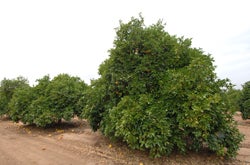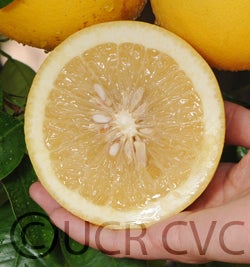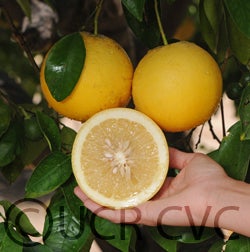Citrus paradisi Macfadyen
CRC 3832
PI 539482
VI 660
Source
Received as seed from Florida, via W. Reuther, UCR, 1962.
Parentage/origins
Parents unknown. Duncan grapefruit is believed to be the oldest grapefruit variety grown in the United States. Although not named until 1892, it was growing as early as 1830 near Safety Harbor, Florida.
Rootstocks of accession
Carrizo citrange, C-35 citrange
Season of ripeness at Riverside
January to May
Notes and observations
OJB: The tree is large, spreading, and grows vigorously. The fruit is almost round and has a smooth, light yellow rind. The flesh is very pale yellow, juicy, and seedy. The flavor is considered by many to be superior to similar seedless grapefruit varieties. Duncan is considered to be somewhat early in maturity. The fruit holds well on the tree. As with other grapefruit varieties, it should be grown in locations that can satisfy its high heat requirement.
5/29/2009, DK & TS: Flavor rich, fruity, intense, less bitter; seedy.
Description from The Citrus Industry Vol. 1 (1967)
"Fruit large, oblate to globose or broadly obovate; basal furrows short and radiating; areolar ring faint; seedy. Color pale to light yellow. Rind medium-thick and surface smooth and even. Flesh color buff to chamois-colored; tender, very juicy; flavor pronounced and excellent. Medium-early in maturity.
Tree vigorous, large, very productive, and reputed to be probably the most cold-resistant.
This variety represents the oldest grapefruit clone grown in Florida, though it was not named and introduced until about 1892. As near as can be determined, the parent seedling tree was planted around 1830 near Safety Harbor, on the Pinellas Peninsula, Florida. The seed came from a tree in the original planting made by Count Odette Phillippe, who is credited with having brought the grapefruit to Florida from the West Indies. It was named for the introducer, A. L. Duncan of nearby Dunedin.
Since the grapefruits are highly polyembryonic and all varieties and seedlings in Florida trace back to the planting which contained the seed parent of Duncan, the probability is good that many, if not most, of them represent the same clone. Certainly many of the early named varieties are indistinguishable from Duncan and have been marketed under that name. It has recently been established (Cooper, Reece and Furr, 1962) that the Bowen variety used in some of the early citrus breeding work in Florida was in reality Duncan.
In flavor, Duncan has remained the standard of grapefruit excellence in Florida although seedless varieties have largely displaced it in the fresh fruit markets. With the advent of processing, however, its flavor and better suitability for canning have renewed interest in this excellent variety and it constituted about 7 per cent of the grapefruit planted between 1956 and 1966."
Availability
Commercially available in California through the Citrus Clonal Protection Program. Click here to order budwood.
USDA Germplasm Resources Information Network page for Duncan grapefruit



